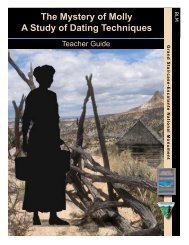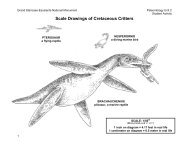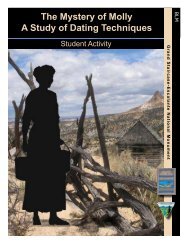Plate Tectonics and the Rock Layers of Grand ... - Gsenmschool.org
Plate Tectonics and the Rock Layers of Grand ... - Gsenmschool.org
Plate Tectonics and the Rock Layers of Grand ... - Gsenmschool.org
You also want an ePaper? Increase the reach of your titles
YUMPU automatically turns print PDFs into web optimized ePapers that Google loves.
Gr<strong>and</strong> Staircase-Escalante National Monument Geology Unit 2<br />
Student Activity<br />
Time formed<br />
<strong>Rock</strong><br />
Appearance:<br />
Special features<br />
Environment when<br />
formed<br />
Similar modern day<br />
habitats<br />
Missing rock layers<br />
VIII. Eastern – Morrison Formation – Jm<br />
~150 mya, Mesozoic/Late Jurassic<br />
River deposited s<strong>and</strong>stone, mudstone<br />
Gray, blue, red/purple/green <strong>and</strong> yellow-brown streaks; 0 to 900<br />
feet; some members cliff forming, o<strong>the</strong>rs slope-forming.<br />
Low grade uranium; in nor<strong>the</strong>rn Utah, this layer has Dinosaur<br />
National Park’s fossils<br />
Lowl<strong>and</strong>s with rivers, streams, <strong>and</strong> <strong>the</strong>ir associated s<strong>and</strong>bars;<br />
floodplains <strong>and</strong> gravel beds (conglomerates)<br />
Braided rivers <strong>and</strong> streams similar to those coming <strong>of</strong>f <strong>the</strong> Andes<br />
Mountains in South America<br />
Ano<strong>the</strong>r unconformity<br />
IX. Dakota Formation –K<br />
Time formed<br />
<strong>Rock</strong><br />
Appearance:<br />
Special features<br />
Environment when<br />
formed<br />
Similar modern day<br />
habitats<br />
~95 mya, Mesozoic/Late Cretaceous.<br />
S<strong>and</strong>stone, mudstone, shale, conglomerate, <strong>and</strong> coal.<br />
Brown, yellow, gray; 0-250 feet, mostly slope-forming.<br />
Some coal present. Dakota S<strong>and</strong>stone is one <strong>of</strong> <strong>the</strong> most<br />
widespread formations in <strong>the</strong> western United States. It forms <strong>the</strong><br />
upper part <strong>of</strong> <strong>the</strong> Gray Cliffs, which are not as visually striking as<br />
<strong>the</strong> White Cliffs below <strong>and</strong> Pink Cliffs above. The Gray Cliffs lack<br />
towering, massive cliff faces, <strong>and</strong> have a ra<strong>the</strong>r rounded or eroded<br />
appearance.<br />
Varied. Shallow marine <strong>and</strong> near shore swamps. The Western<br />
Interior Seaway was advancing into <strong>the</strong> North American Continent,<br />
extending from <strong>the</strong> Gulf <strong>of</strong> Mexico to <strong>the</strong> Arctic, depositing belowsurface<br />
s<strong>and</strong>stone <strong>and</strong> o<strong>the</strong>r layers. Over <strong>the</strong> next tens <strong>of</strong> millions <strong>of</strong><br />
years, <strong>the</strong> sea would rise <strong>and</strong> fall, sometimes leaving marine<br />
sediments, <strong>and</strong> o<strong>the</strong>r times retreating to allow terrestrial<br />
environments. Coal was formed in lagoon swamps with lush plant<br />
growth.<br />
Coastlines <strong>of</strong> Florida or Louisiana.<br />
10





